Indiana University Libraries Book Repair Manual
Reback - outside
There are two varieties of the reback treatment (sometimes called recase with spine repair). One involves going over the old cover material with the new spine cloth; the other involves going under it. Which of the two methods is used usually depends on:
* whether or not one or both of the original boards bear text and/or images it is desirable to avoid covering from view with the new spine cloth and/or
* the ease or difficulty involved in lifting the book's original cover material.
The procedure documented here is for going unover the original cover material. So, the criteria specific to the outside recase with spine repair (a.k.a. reback) are:
- text block is of stitched construction
- case-to-text block attachment not intact, super torn (any, at all)
- structure and materials of text block will withstand re-binding
- case is suitable for further circulation, but…
- suffers damage or wear only at spine
- boards do not bear text and/or images
- the original cover material is suitable for lifting
Materials Needed: |
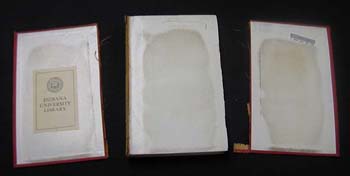 | First, the text block is removed from the case by appropriate means. When the two are not totally detached from each other, this involves cutting the super. Here we see that the case to text block attachment is totally disengaged, so no cutting needs to be done. Any loose leaves that stay with the case are either cut or merely pulled out and tipped back on to the text block. |
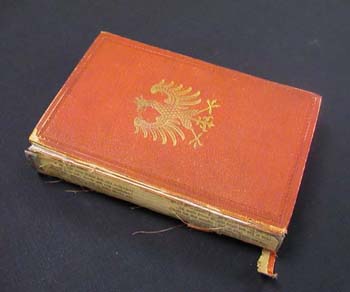 | In looking at the case, we see that the condition of the boards is such that it is acceptable to re-use them. However, the old cover material is damaged (missing, in fact) at the spine. Here we face a general collections conservation decision. The boards are ornamented around the perimeter by a row of blind tooling. It would be ideal to leave this unobscured, but the cover material is too brittle to survive lifting. So, we will leave three of the four tooled edges exposed, along with the gold graphic in the center. |
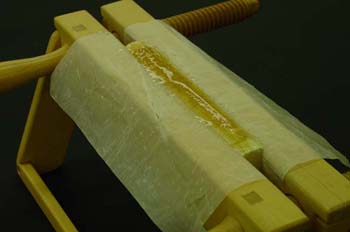 | The text block is placed in a finishing press, masked with waxed paper, and a coat of methyl cellulose is applied to the spine edge. Methyl cellulose dissolves hide glue and some modern adhesives. It is left on the spine for about 10-20 minutes, before removal (which amounts to careful scraping with a microspatula) is attempted. Sometimes a second application/scraping cycle is necessary.
|
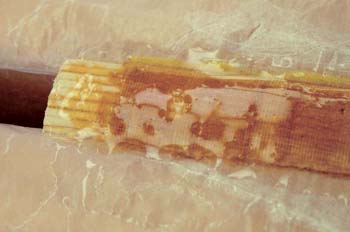 | Here we see a close-up of the old super and adhesive we will be removing, and … |
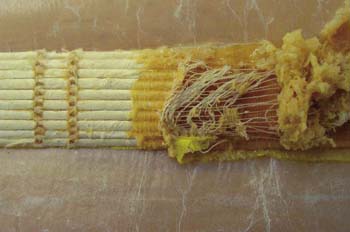 | … in this close-up, we see the removal in progress. Shown in layers for illustration, we see the old super, the old adhesive, and the clean text block. |
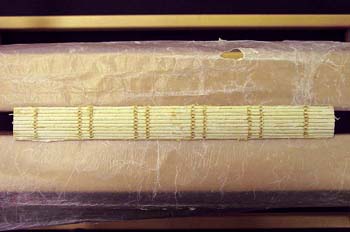 | And here we have the cleaned text block. |
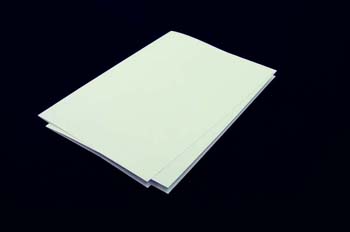 | The new end sheets are of double folio construction, and have a cloth hinge. The paper is Mohawk and the hinge is regular hinge cloth. To begin, four folios of length and width dimensions greater than those of the text block are made up (or selected from the pre-cut materials bins, if you keep them made up). |
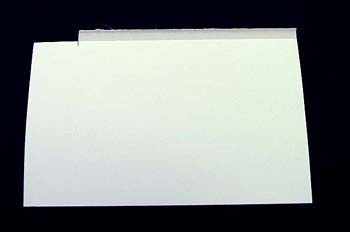 | The end sheets are marked and cut to the length of the text block. If you have one, the board shear works well for cutting them off. Otherwise, they are trimmed using a knife and straight edge. In either case, the cut must be square with the spine edge. |
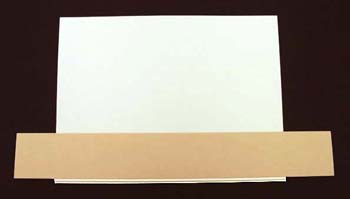 | The outer folios are now constructed. Two folios are stacked as shown, and a paper mask is placed on top of the upper one (a mask of colored paper was used only for the sake of illustration). The overlap is not less than 1/8" and not greater than 3/16". |
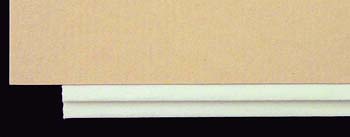 | Here is a close-up of this arrangement. |
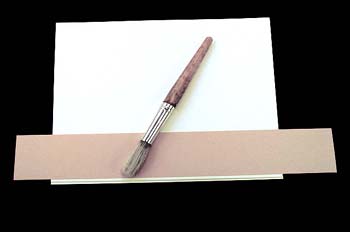 | PVA mixture is applied rather liberally to the exposed areas. |
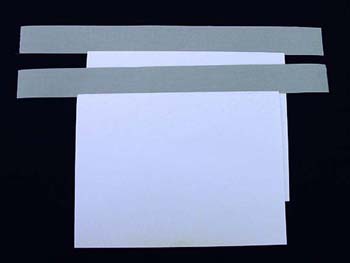 | Strips of hinge cloth approximately 1 ¼" wide are now applied. |
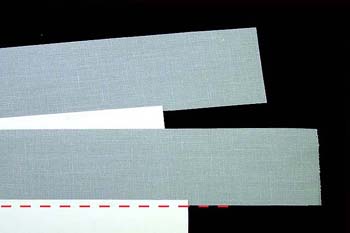 | Here is a close-up showing the overlap of the hinge cloth. |
 | The hinge cloth is now trimmed to a very slight inward angle. |
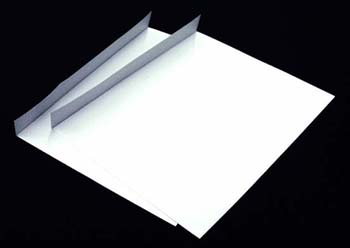 | The hinge cloth is folded over double and creased at the spine edge, using a bone folder. |
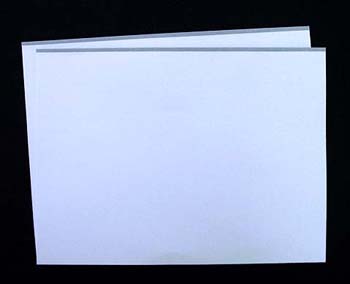 | The sides where the hinge cloth is attached to the folios should now look like this. |
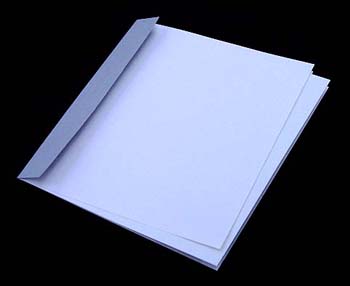 | The inner folios are placed inside the hinge-bearing outer folios, and end sheet construction is complete. |
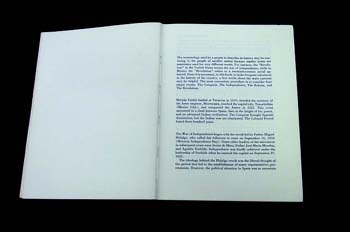 | The center of the outermost signature of the text block is located. This will be marked by visible thread stitching. |
 | Here is a close-up of what you're looking for: stitching that runs the length of the text block. |
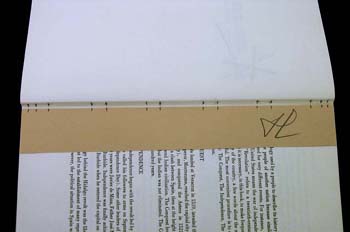 | A paper template is made, and the location of the sewing stations is marked on both the template and the text block. (Note: The experienced conservation technician often dispenses with the making and use of the paper template, instead sighting the marks by eye and sewing "freehand". The template is a great aid for the inexperienced and it is advisable to use it until it is comfortable to work without it. Also, the marks on the text block are exaggerated in the photo for the sake of illustration. In practice, they are minimal and are not visible when attachment of the end sheets is finished.)
|
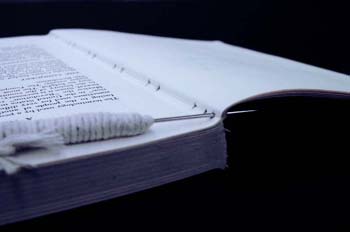 | Holes are punched (redefined, if following original stitching) in the text block, at the marks, using an awl, biological dissection probe, or similar tool.
|
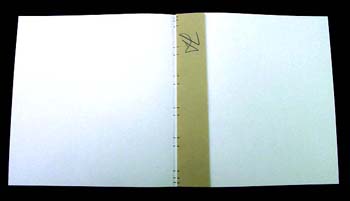 | The marks from the template are now transcribed onto the new end sheet; in the center fold of the inner folio, on the inside. |
 | The end sheet is punched through both folios at the marks. |
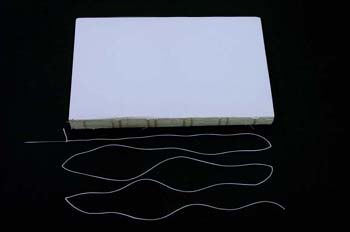 | The length of thread cut off the spool is 5 times the length of the text block. Each end sheet will require 2 ½ lengths, so by starting with 5, the time of one threading/piercing is saved. Of course, if the book is extremely large (tall), it may be more feasible to thread twice, once for each end sheet, rather than battle with a huge length of thread. |
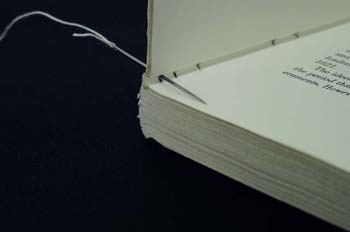 | Sewing commences with the text block, at one end or the other (it doesn't matter which). The first stitch begins on the outside and goes in. |
 | The next move is to go back out the next hole. |
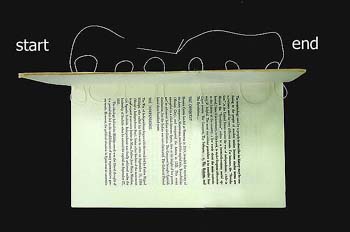 | From there, the stitching pattern follows a simple linear in-and-out pattern, as shown. |
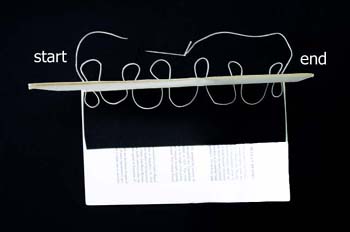 | In order to even more vividly illustrate the stitching pattern, the same view as that of the previous image is shown, but with a piece of dark material serving as a contrasting background for the loops on the inside of the text block. |
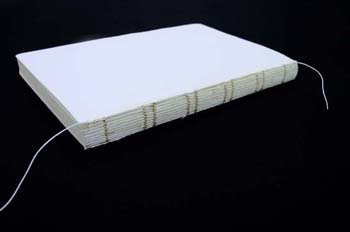 | All stitches are pulled tight, and the text block looks like this. Double-check inside to make sure that no loops of loose thread were overlooked. |
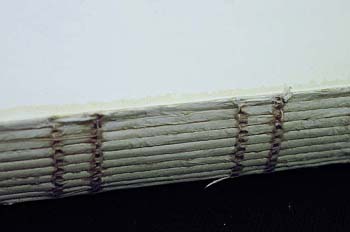 | Here's a close-up of what the stitching should look like on the outside at this point. |
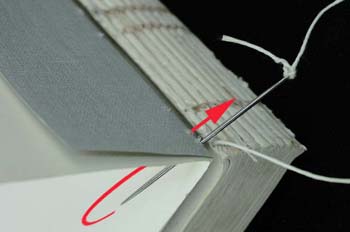 | Attachment of the end sheet begins with the same in-and-out that began the stitching of the text block (the "out" being indicated by the red arrow). In the image, you will also see the last stitch coming out of the text block. |
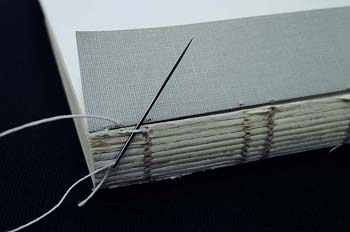 | Here is the only detail of end sheet stitching that differs from the text block stitching. The needle is hooked under the short loops of the text block stitching … |
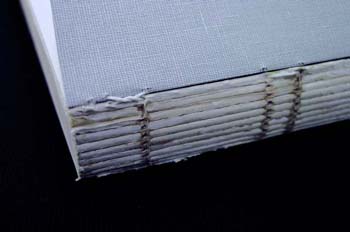 | … which interlocks the stitches when pulled tight. |
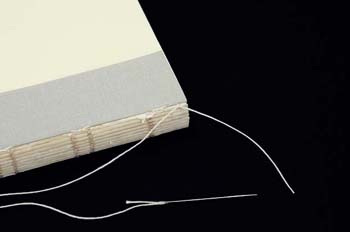 | This pattern is followed the length of the text block. When the end is reached, the thread in the needle and the beginning tail of thread are tied off in a simple cross knot (if you only know one knot, that's the one), followed by a second knot of the same type. (It is important that two knots be tied here.) |
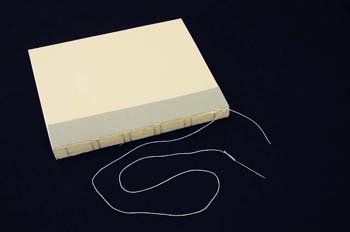 | You will see that there is enough thread in the needle to complete the sewing on of the other end sheet. |
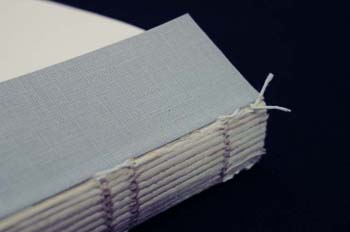 | Both ends of the thread are now trimmed to about 3/8." The attachment of the first end sheet is now complete. The other end sheet is now attached following the same procedure. |
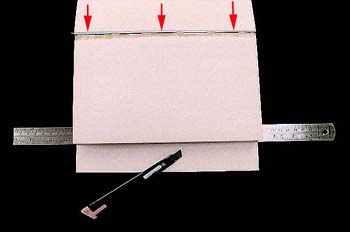 | You may have noticed a few steps back that we only trimmed the end sheets to the length of the text block, but not to its width. That's because it's a lot easier and really more accurate to wait and do it after the end sheets are attached (or the first end sheet can be trimmed as soon as attachment is complete, before beginning the attachment of the second end sheet…it doesn't matter whether it's done then or now). A steel ruler is placed on top of the end sheet, flush with the fore edge of the text block, and the cutting is done with a knife.
|
 | The text block is now placed back in the finishing press, where it will receive the new headbands, super, and paper spine inlay, in that order. Headbands amount to strips of hinge cloth, running grain-short, folded double and with a piece of cotton twine inserted in the fold. If you are going to be doing any quantity of work that will require headbands, it is time-efficient to make up strips of headband material. About 18" to 24" seems to be a good length to work from. The total width (height, actually) of these strips is about 1 ¼." |
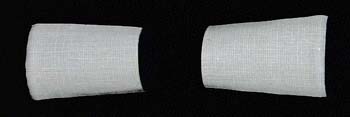 | From this strip of headband material, two pieces are cut, each of which is the width of the text block. It is helpful to curl the headbands in the direction indicated in the image, by means of simply rolling them up. They will conform much better to the curve of the text block if this detail is attended to. Of course, if the spine edge of the text block is flat, this isn't a concern. |
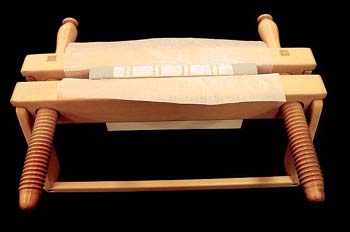 | Here we see the text block with the headbands attached. They are affixed with PVA mixture and then rubbed down with a bone folder. They are positioned so that the thickness of the twine just overhangs the ends of the text block. |
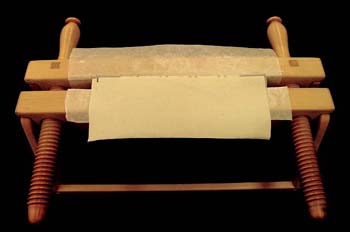 | Next comes the super. It is trimmed to the length of the text block only…not including the length the headbands just added to it. As you can (somewhat) see in the photo, the length is marked at the inside of the headbands' twine. |
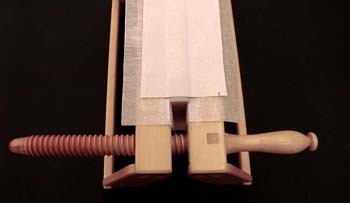 | The super is marked for width; about 1" to 1 ¼" beyond the width of the text block on each side. |
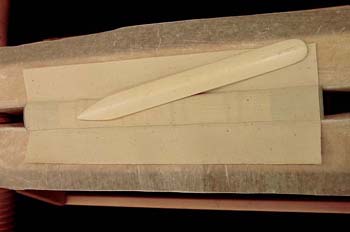 | PVA mixture is applied (rather liberally) to the spine of the text block (not to the super). The super is positioned on the text block, centered both ways, and rubbed rigorously with a bone folder. |
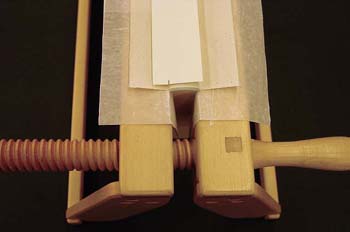 | Finally, the paper (Mohawk) spine inlay is marked and trimmed in the same manner as the super. Again, the length is actual text block length. The width is that of the text block. |
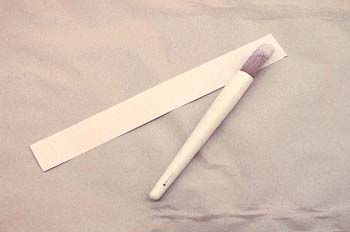 | Once trimmed, the spine inlay is laid on a piece of scrap paper and PVA mixture is applied to it (not to the text block). |
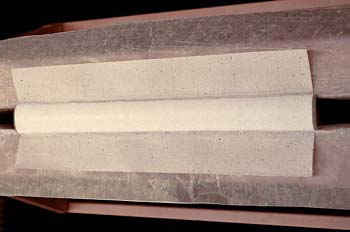 | The spine inlay is applied to the text block and rubbed very rigorously with a bone folder; until an actual slight gloss has been burnished. The text block is now left in the finishing press until the following day. |
 | Here we see the text block on removal from the finishing press. The headband, super, and cloth hinge of the end sheet are all visible. |
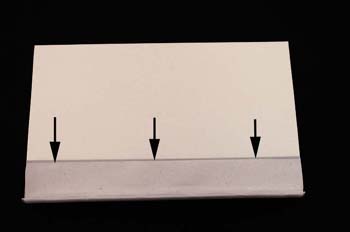 | One last detail before starting on casing in is to trim the super back to just smaller in width than the cloth hinge of the end sheet, as shown at the arrows. Also, it may be necessary to trim the ends of the super to match the slight inward angle at the ends of the cloth hinges of the end sheets. |
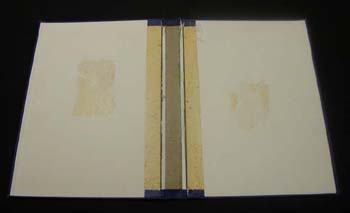 | The reconstruction of the case is now undertaken, using the original boards. The first step is to clean the inner surfaces of the boards. They are taken down to bare board, about an inch back from the spine edge. This is to ensure a good bond with the new super. The old turn-ins are not normally not cut off; instead they are lifted and re-affixed with fresh glue. |
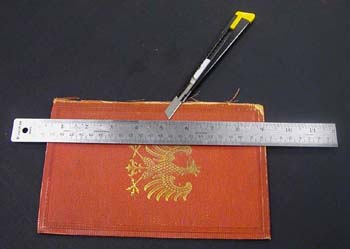 | Cuts are made about ¾" from the board edge and at the top and bottom, and again the scrap is removed, leaving bare board exposed. If the spine of the case was intact to begin with, as of this step it is no longer; the case is now in three pieces, the two boards and the spine piece. If salvageable, the original spine material is set aside to be cleaned and re-applied later. |
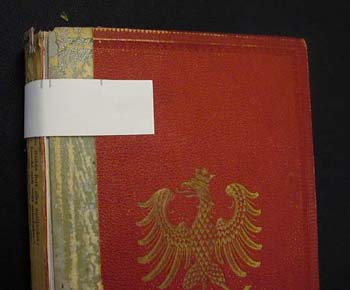 | The boards are positioned on the text block so that there is a uniform 3mm of square at the fore edge (the top and bottom should show close to 3 mm each, but exact lengthwise positioning is not critical at this point). A paper template is wrapped around the spine and marks are made on both front and back sides of the book. These marks are made at the following locations (outermost to innermost):
|
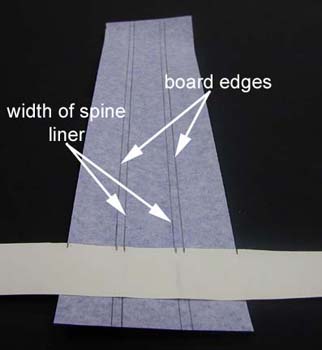 | The cloth is selected and trimmed to the following dimensions:
|
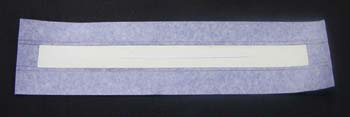 | The spine inlay is made from text weight paper. The width measurement is taken from the inner marks of the paper template. The length is that of the boards. It is affixed to the cloth, aligned with the inner marks transcribed from the template, and 2.5 cm from each end (this will be flush with the boards). The paper inlay is laid on a piece of scrap paper, PVA mixture is applied to it, and it is affixed to the cloth.
|
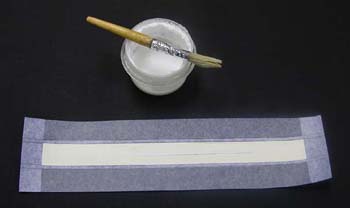 | PVA mixture is applied to the cloth from its outer edges over to the board edge marks, stopping about 1" from the ends of the cloth. The shaded area shows the area to which the adhesive is applied. |
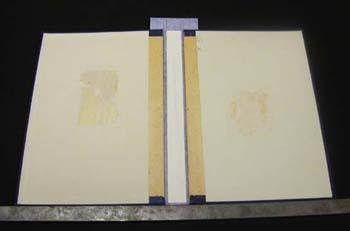 | The boards are aligned with the board edge marks and along a straight-edge at the bottom and are centered lengthwise with 1" of cloth protruding at both ends. |
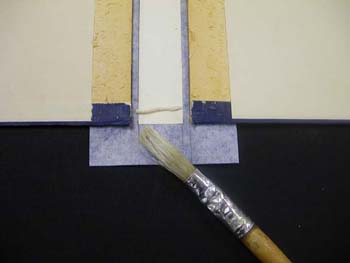 | Two pieces of cotton twine are cut. Their length is the width of the paper inlay. PVA mixture is applied to the new turn-in. The twine is centered across the width and snugged into the fold of the cloth. |
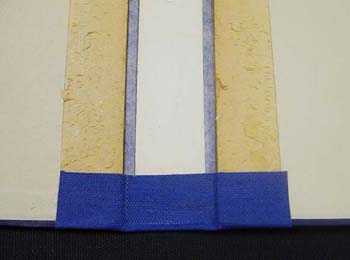 | Here is a close-up look of the finished turn-in, showing the position of the cotton twine. The cloth is formed around the twine and the board edges, using a bone folder. |
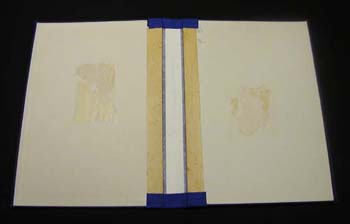 | The case is now back in one piece again. Here is shown the interior view with finished turn-ins. The case is now ready for re-installation of the text block. |
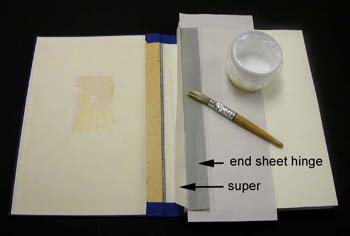 | The text block is situated in the case so that it is centered both vertically and horizontally, yielding the proper amount of square (3mm) on all three edges. The book is placed on the bench, making sure the text block doesn't shift in the case. Once this has been accomplished, one board is opened and a piece of scrap paper is placed under the flaps of the super and the cloth hinge of the end sheet. |
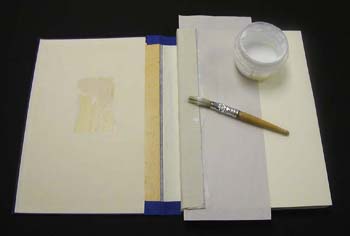 | PVA mixture is applied first to the cloth hinge of the end sheet, and the super is folded down onto it.
|
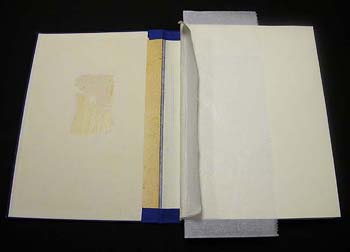 | And then the adhesive is applied to the super. The scrap paper is removed and replaced with a piece of waxed paper (the heavier the better). The book is now closed, turned over, and the process repeated on the book's other side. |
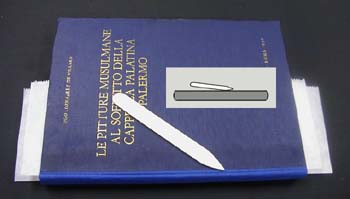 | The joint is defined, using a bone folder. The matter of seating the edge boards in their proper locations is made considerably easier by doing this. The angle of the bone folder is to be kept very low to avoid damaging the cloth (see inset). If that happens, all the work on the spine of the case has been wasted and must be undone and started over. |
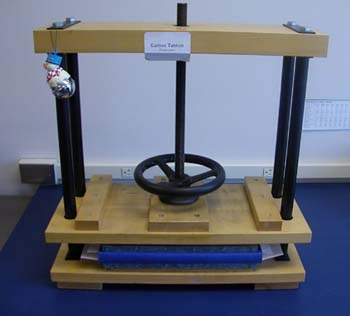 | The book is placed in a standing press until the following day. |
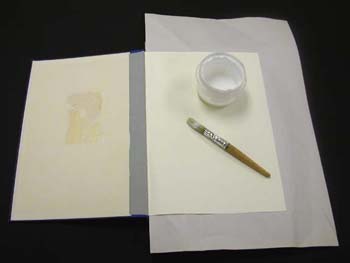 | The book is removed from the press and laid open on the bench. A piece of scrap paper is placed under the outermost leaf of the end sheet, which becomes the paste-down. PVA mixture is applied to the entire page. The board is closed, then the book is placed back in the standing press for another day or so. |
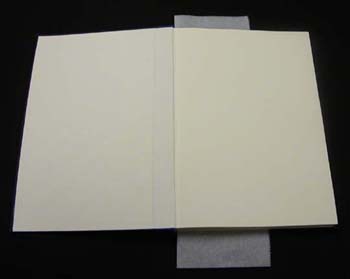 | Here we see the finished paste-down. |
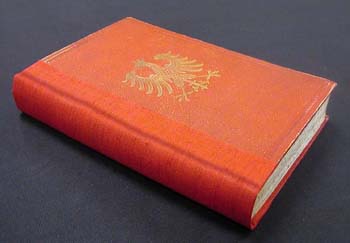 | The book has returned to a state of functional well-being; the structural work is finished. |
 | If the original spine labeling has been salvaged, it is cleaned of old paper using methyl cellulose and re-attached using PVA mixture. Otherwise, a new spine label is made. |
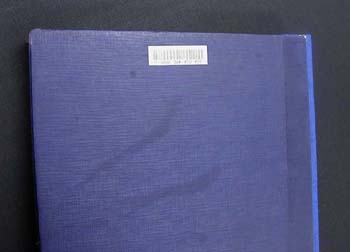 | If the book is barcoded, the barcode is now re-attached; same for any salvaged book plates, ex libris plates, etc. |
 | The book is now ready to circulate. |